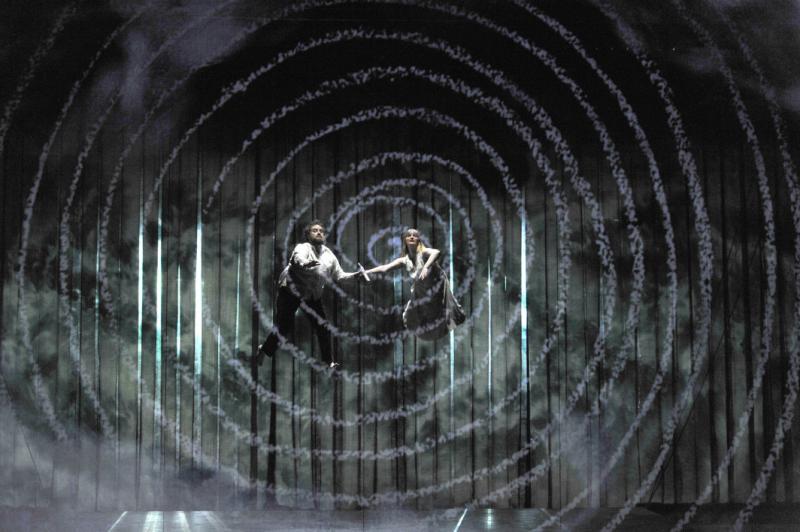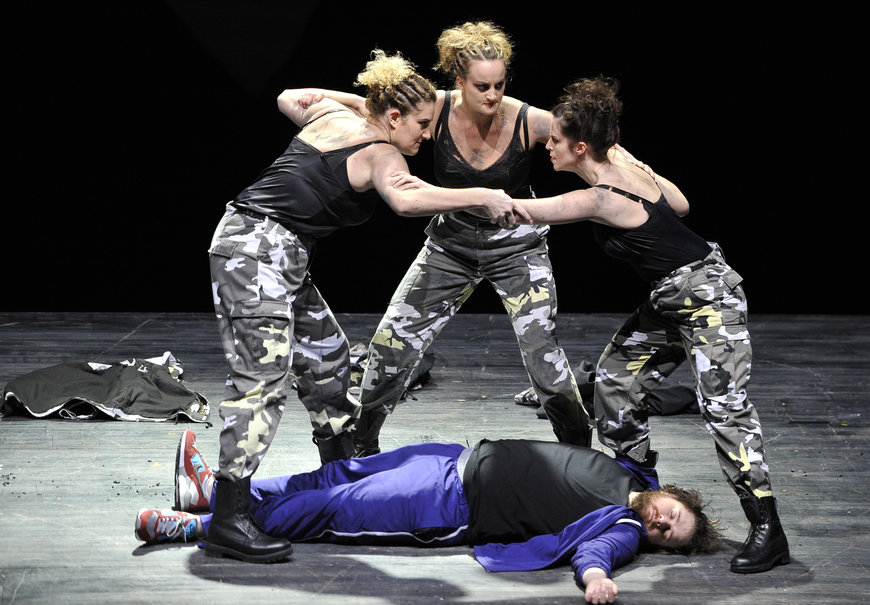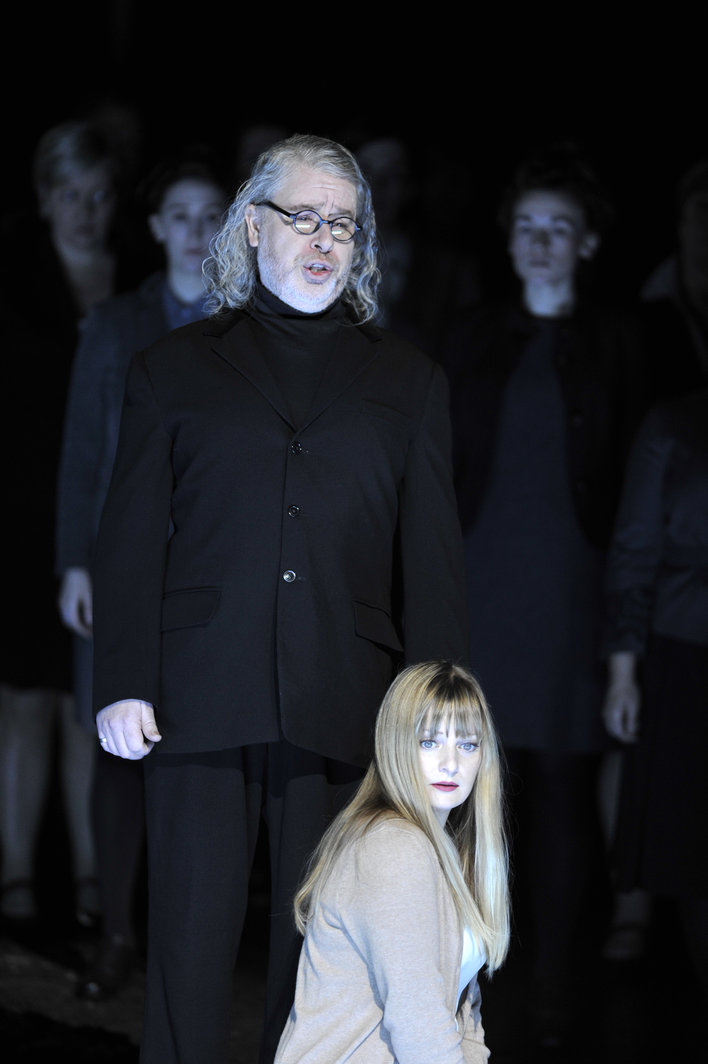The Magic Flute, English National Opera | reviews, news & interviews
The Magic Flute, English National Opera
The Magic Flute, English National Opera
Mozart's opera rediscovers its magic in this revelatory revival

“We are at a time of present crisis.” When Sarastro addressed his boardroom of business-suited acolytes last night, there can’t have been many in the Coliseum whose thoughts didn’t turn to English National Opera. Even by the standards of a company that has spent most of its history fighting for survival, 2015 was a year of unprecedented difficulty.
Even this visual charge is nothing to the heat coming off Wigglesworth’s orchestra
Simon McBurney, theatre’s magus-in-chief, should always have been a good fit for Mozart’s phantasmagorical fantasy. Perhaps it was the unusual restrictions and demands of the opera house that stymied things last time round, but true to the director’s process of meticulous devising, revising and workshopping, this first revival is a different creature to that flat, heel-dragging evening.
Where Nicholas Hytner’s Flute gave us charm and David McVicar’s Royal Opera production brings beautiful stage-pictures, McBurney’s is pure invention. It’s a bold imagination that takes a work beloved for its magic and strips that all away, exposing the nuts and bolts of theatrical illusion, from Foley artists and videographers (positioned in full view of the audience), to the orchestra itself, raised up from the pit and on show. It takes an even greater imagination to pull back the theatrical curtain and somehow still sustain the illusion, all the greater for the new complicity of the audience.
 From Finn Ross’s elegantly manipulated video designs and Matthieu Maurice’s vivid soundscapes to Robin Beer’s delightfully naïve chalk projections, we’re bombarded with sensation. If that sensory excess, coupled with the complications of Mozart’s plot, occasionally proves distracting, it also generates an energy that helps propel this baggy drama.
From Finn Ross’s elegantly manipulated video designs and Matthieu Maurice’s vivid soundscapes to Robin Beer’s delightfully naïve chalk projections, we’re bombarded with sensation. If that sensory excess, coupled with the complications of Mozart’s plot, occasionally proves distracting, it also generates an energy that helps propel this baggy drama.
But even this visual charge is nothing to the heat coming off Wigglesworth’s orchestra. From the nervy, dangerously swift Overture to the final chorus, he keeps the pace up throughout, while still finding space for moments of musical contemplation all the more ecstatic for their rarity. Lucy Crowe’s rapturous “Tamino mine” will stay in the ears for a long time, and Allan Clayton’s “Portrait" Aria (Clayton pictured above, with Eleanor Dennis, Catherine Young and Rachael Lloyd as the Three Ladies) is just the start of an evening of lyrical, generously projected beauty. The raised orchestra makes for a more prominent instrumental balance, but while we gain colour and some gorgeous shading, Wigglesworth’s careful balancing ensures we lose little from the singers.
 In Crowe and Clayton the production has gained immeasurably, both vocally and dramatically – lovers whose uncomplicated sincerity carries off their sudden courtship, whose sweetness is tempered by Peter Coleman-Wright’s bluff Papageno. While the production doesn’t entirely convince me that an older Papageno is an improvement on the usual thirty-something (and reducing a role with such fine music to character singing isn’t ideal), Coleman-Wright brings bags of personality and some unexpectedly fine keyboard skills to his bird-catcher. James Creswell’s Sarastro (pictured above with Crowe) is a cult-leader whose singing could convince anyone to follow – a fine foil for Ambur Braid’s strident but efficient Queen of the Night, whose bitter venom infects even her music. Only Stephen Jeffreys’s translation still chafes in its attention-drawing archaisms and verbal fuss, a layer too far in an already heavy-laden production.
In Crowe and Clayton the production has gained immeasurably, both vocally and dramatically – lovers whose uncomplicated sincerity carries off their sudden courtship, whose sweetness is tempered by Peter Coleman-Wright’s bluff Papageno. While the production doesn’t entirely convince me that an older Papageno is an improvement on the usual thirty-something (and reducing a role with such fine music to character singing isn’t ideal), Coleman-Wright brings bags of personality and some unexpectedly fine keyboard skills to his bird-catcher. James Creswell’s Sarastro (pictured above with Crowe) is a cult-leader whose singing could convince anyone to follow – a fine foil for Ambur Braid’s strident but efficient Queen of the Night, whose bitter venom infects even her music. Only Stephen Jeffreys’s translation still chafes in its attention-drawing archaisms and verbal fuss, a layer too far in an already heavy-laden production.
Mozart’s flute may enchant the most dastardly of villains, but its magic is as nothing to the sleight of hand that Mark Wigglesworth has performed with this glorious revival. Now we can only wait and hope that he can pull off the same trick with the ailing ENO itself.
- The Magic Flute at ENO until 19 March
rating
Explore topics
Share this article
The future of Arts Journalism
You can stop theartsdesk.com closing!
We urgently need financing to survive. Our fundraising drive has thus far raised £33,000 but we need to reach £100,000 or we will be forced to close. Please contribute here: https://gofund.me/c3f6033d
And if you can forward this information to anyone who might assist, we’d be grateful.

Subscribe to theartsdesk.com
Thank you for continuing to read our work on theartsdesk.com. For unlimited access to every article in its entirety, including our archive of more than 15,000 pieces, we're asking for £5 per month or £40 per year. We feel it's a very good deal, and hope you do too.
To take a subscription now simply click here.
And if you're looking for that extra gift for a friend or family member, why not treat them to a theartsdesk.com gift subscription?
more Opera
 Help to give theartsdesk a future!
Support our GoFundMe appeal
Help to give theartsdesk a future!
Support our GoFundMe appeal
 Simon Boccanegra, Opera North review - ‘dramatic staging’ proves its worth
Verdi’s political tragedy - and plea for peace - has impact in a grand Yorkshire setting
Simon Boccanegra, Opera North review - ‘dramatic staging’ proves its worth
Verdi’s political tragedy - and plea for peace - has impact in a grand Yorkshire setting
 Peter Grimes, Welsh National Opera review - febrile energy and rage
In every sense a tour de force
Peter Grimes, Welsh National Opera review - febrile energy and rage
In every sense a tour de force
 Owen Wingrave, RNCM, Manchester review - battle of a pacifist
Orpha Phelan brings on the big guns for Britten’s charge against war
Owen Wingrave, RNCM, Manchester review - battle of a pacifist
Orpha Phelan brings on the big guns for Britten’s charge against war
 Tales of Apollo and Hercules, London Handel Festival review - compelling elements, but a failed experiment
Conceptually the two cantatas just don't work together
Tales of Apollo and Hercules, London Handel Festival review - compelling elements, but a failed experiment
Conceptually the two cantatas just don't work together
 La finta giardiniera, The Mozartists, Cadogan Hall review - blooms in the wild garden
Mozart's rambling early opera can still smell sweet
La finta giardiniera, The Mozartists, Cadogan Hall review - blooms in the wild garden
Mozart's rambling early opera can still smell sweet
 Der fliegende Holländer, Irish National Opera review - sailing to nowhere
Plenty of strong singing and playing, but the staging is static or inept
Der fliegende Holländer, Irish National Opera review - sailing to nowhere
Plenty of strong singing and playing, but the staging is static or inept
 Die Zauberflöte, Royal Academy of Music review - first-rate youth makes for a moving experience
The production takes time to match Mozart's depths, but gets there halfway through
Die Zauberflöte, Royal Academy of Music review - first-rate youth makes for a moving experience
The production takes time to match Mozart's depths, but gets there halfway through
 Mansfield Park, Guildhall School review - fun when frothy, chugging in romantic entanglements
Jonathan Dove’s strip-cartoon Jane Austen works well as a showcase for students
Mansfield Park, Guildhall School review - fun when frothy, chugging in romantic entanglements
Jonathan Dove’s strip-cartoon Jane Austen works well as a showcase for students
 Uprising, Glyndebourne review - didactic community opera superbly performed
Jonathan Dove and April De Angelis go for the obvious, but this is still a rewarding project
Uprising, Glyndebourne review - didactic community opera superbly performed
Jonathan Dove and April De Angelis go for the obvious, but this is still a rewarding project
 Fledermaus, Irish National Opera review - sex, please, we're Viennese/American/Russian/Irish
Vivacious company makes the party buzz, does what it can around it
Fledermaus, Irish National Opera review - sex, please, we're Viennese/American/Russian/Irish
Vivacious company makes the party buzz, does what it can around it
 The Capulets and the Montagues, English Touring Opera review - the wise guys are singing like canaries
There's a bel canto feast when Bellini joins the Mob
The Capulets and the Montagues, English Touring Opera review - the wise guys are singing like canaries
There's a bel canto feast when Bellini joins the Mob

Add comment